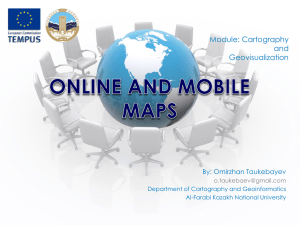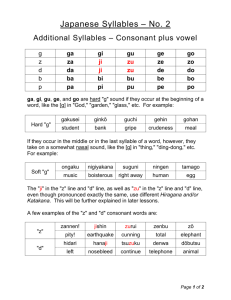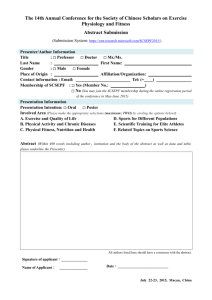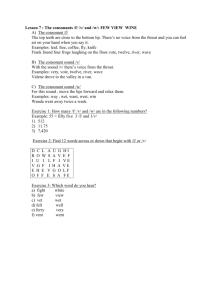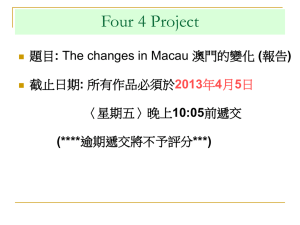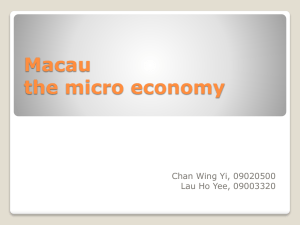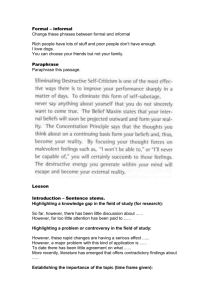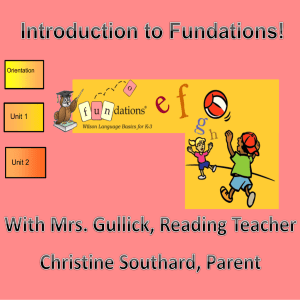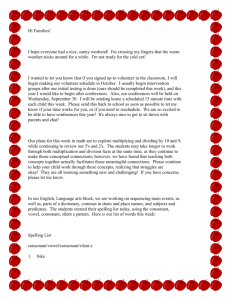Tongue Twisters
advertisement
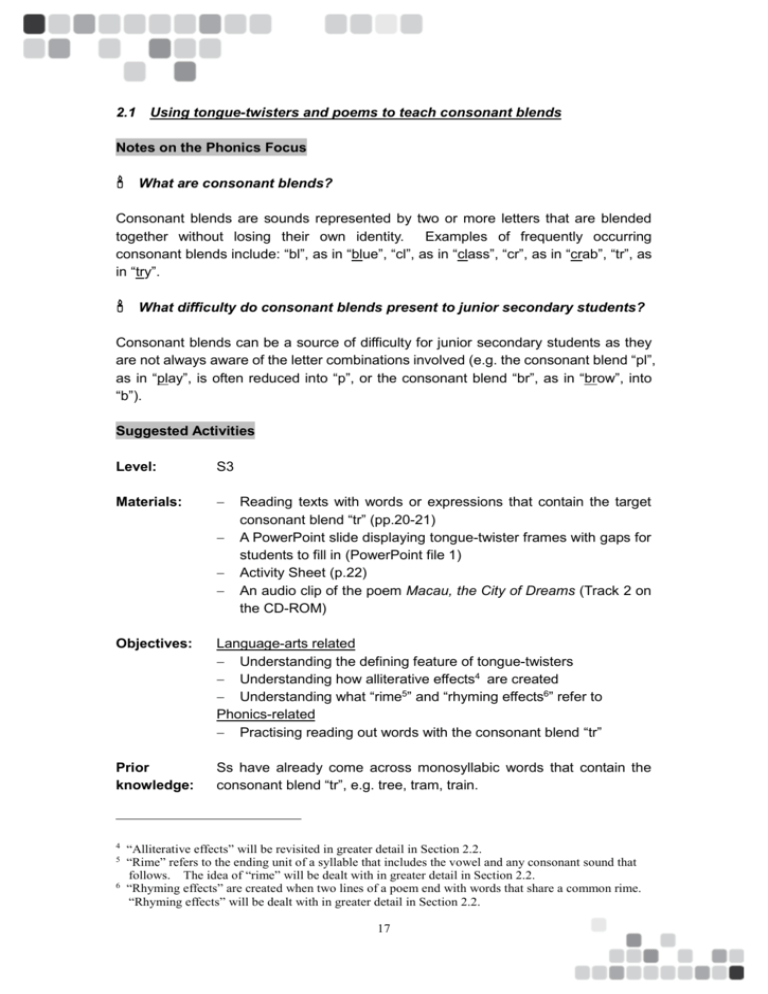
2.1 Using tongue-twisters and poems to teach consonant blends Notes on the Phonics Focus What are consonant blends? Consonant blends are sounds represented by two or more letters that are blended together without losing their own identity. Examples of frequently occurring consonant blends include: “bl”, as in “blue”, “cl”, as in “class”, “cr”, as in “crab”, “tr”, as in “try”. What difficulty do consonant blends present to junior secondary students? Consonant blends can be a source of difficulty for junior secondary students as they are not always aware of the letter combinations involved (e.g. the consonant blend “pl”, as in “play”, is often reduced into “p”, or the consonant blend “br”, as in “brow”, into “b”). Suggested Activities Level: S3 Materials: Reading texts with words or expressions that contain the target consonant blend “tr” (pp.20-21) A PowerPoint slide displaying tongue-twister frames with gaps for students to fill in (PowerPoint file 1) Activity Sheet (p.22) An audio clip of the poem Macau, the City of Dreams (Track 2 on the CD-ROM) Objectives: Language-arts related Understanding the defining feature of tongue-twisters Understanding how alliterative effects4 are created Understanding what “rime5” and “rhyming effects6” refer to Phonics-related Practising reading out words with the consonant blend “tr” Prior knowledge: Ss have already come across monosyllabic words that contain the consonant blend “tr”, e.g. tree, tram, train. 4 5 6 “Alliterative effects” will be revisited in greater detail in Section 2.2. “Rime” refers to the ending unit of a syllable that includes the vowel and any consonant sound that follows. The idea of “rime” will be dealt with in greater detail in Section 2.2. “Rhyming effects” are created when two lines of a poem end with words that share a common rime. “Rhyming effects” will be dealt with in greater detail in Section 2.2. 17 Summary of the activities: Students revisit some travel-related words with the consonant blend “tr” and complete two tongue-twisters using them. They then learn other travel-related words with the same consonant blend taken from two reading texts and complete a poem about Macau using these words. Sharing learning intentions Step 1 Introduce the objectives of the activities. Establishing links with Ss’ prior knowledge Step 2 Write on the blackboard words that contain the consonant blend “tr” and that can be loosely related to the theme of the reading text, which is travel, e.g. traffic, train, tram, travel. Include additional words, such as proper names, if necessary, e.g. Trish, Troy, Tracy. Step 3 Ask Ss to pronounce those words introduced in Step 2 and suggest what they have in common in terms of the letter sounds. Step 4 Show the following half-completed tongue-twisters on a PowerPoint slide (PowerPoint file 1). Ask Ss to listen to the teacher saying out loud the following two tongue-twisters and fill in the blanks with suitable words. Fallen trees brought ________ troubles to the _______ and ______ networks. (traffic, train, tram) Tracy and _______ had trouble catching the ______ to the city of _________. (Trish, train, Troy) Explain what tongue-twisters are. If possible, have Ss suggest what the defining feature of tongue-twisters is with reference to the words used in the two tongue-twisters above (i.e. the repetition of the same initial consonant sound(s) over two or more sequences of sounds to create alliterative effects). Focusing on reading Step 5 Highlight words from the reading texts (pp.20-21) that contain the target consonant blend “tr”, regardless of where it is in the words, e.g. attraction, pedestrian, traditions, travelled, trip. Invite Ss to indicate where the target consonant blend is and group the words based on where it is found. Guide Ss to pronounce these words. 18 Step 6 Ask Ss a variety of comprehension questions that not only require the use of the target words to answer, but also cover both lower-order and higher-order thinking, e.g. What can you see in the Museum of Macau? (the history and traditions of Macau) Can cars get into the Senate Square? Why/Why not? (No, cars cannot get into it because it is a pedestrian area.) Which of the attractions described in the text would you most want to visit? Why? (Any reasonable answers) Applying phonics Step 7 Give out the Activity Sheet on p.22. Draw Ss’ attention to the title of the poem and guide them to find out why Macau is called “The City of Dreams” in the poem. Step 8 Highlight Lines 13 & 14 and Lines 20 & 21, and focus Ss’ attention on the last word of each pair of lines (i.e. “distance” & “abundance”; “trails” & “details”). Ask Ss to suggest what the two words in each pair have in common. (The first pair of words end in “ance”. The second pair of words end in “ails”.) Briefly introduce what “rime” is. Point out that the two words in each pair have the same rime and they therefore rhyme with each other. Check if Ss know what effects are created in a poem through the use of words with the same rime. (Rhyming effects) Step 9 Draw Ss’ attention to Lines 3 & 4, Lines 6 & 7 and Lines 10 & 11. Have them fill in each blank with one of the given words (which are introduced in Step 5), so that it rhymes with the final word in the following line. Then instruct Ss to fill in the blanks in Line 13 and Line 17 with other given words. Step 10 Read aloud the poem or play the recording of the poem on the CD-ROM (Track 2) for Ss to check the answers. As an extension activity, invite Ss to identify all the words that contain the target consonant blend “tr” on top of the given ones. Have Ss read out the poem to check their pronunciation of the target vocabulary items. Reviewing progress Step 11 Guide Ss to reflect on what they have learnt, with reference to the objectives of the activities. 19 Reading Texts Visit Macau! Do you enjoy sightseeing and eating? If your answer is yes, you’ll definitely love visiting Macau, a place full of culture and beauty. Join us on our exciting two-day tour! Our tour begins at the Ruins of St Paul’s. A fire destroyed this famous church many years ago, but one wall still remains. Tourists from all over the world come to visit these famous ruins. Next, we’ll visit the Museum of Macau, which shows you the history and traditions of the city. You should miss none of the exhibits! They are all fascinating! After that, we’ll go to Macau Tower, the 10th tallest tower in the world. This is certainly the best place to see the city! The next day, we’ll enjoy many of the best foods of Macau. Anyone who has visited Macau will tell you the food is hard to resist! One of the places we’ll take you to is Lord Stow’s Bakery — nobody should miss the egg tarts there! Finally, we’ll end our tour at Nam Van Lake, where we’ll watch an excellent laser show. Come and join our tour! There’s something for everyone in Macau! Content in this part is reproduced with permission of the Oxford University Press (OUP) from New Treasure Plus Student’s Book (2010) 3A Unit 1. All rights of the permitted content are reserved by OUP. All unauthorised reproduction and distribution of the permitted content are prohibited. 20 My trip to Macau Someone told my father about Macau. After reading a travel brochure about it, none of my family wanted to miss the chance to go there! So last weekend, we travelled to Macau. There was nothing particular to do on the ferry, but we had a good time chatting with each other. On our first day in Macau, we did some sightseeing. We visited the Ruins of St Paul’s and A-Ma Cultural Village. Then, we went shopping in Senate Square, a paved pedestrian area in the centre of Macau. Popular tourist attraction Macau Tower was our last stop that day. On the second day, we went to Hac Sa Beach. There wasn’t anything interesting to see except for the black sand. But all of us enjoyed swimming there — none of us wanted to leave before sunset! We tried a lot of local foods throughout our trip — egg tarts, pork chop buns and peanut sweets. No one should miss any of these! Macau is a really nice place to visit. I’ll definitely visit it again! Posted at 21.00 by Travelkid Content in this part is reproduced with permission of the Oxford University Press (OUP) from New Treasure Plus Student’s Book (2010) 3A Unit 1. All rights of the permitted content are reserved by OUP. All unauthorised reproduction and distribution of the permitted content are prohibited. 21 Activity Sheet Read the following poem. Fill in the blanks with one of the following words with the consonant blend “tr”: travelled trips traditions pedestrian attractions Macau, the City of Dreams 5 10 15 20 Macau, The City of Dreams, Rich in history and __________ With streets lined by colourful constructions, Left behind by people Who made many thousand-mile _______ On their sailing ships. Macau, The City of Dreams, Full of wonderful _____________ Of a grand mix of architectural creations, Brought to us by people Who _________ long distance For a brave new world of abundance. Macau, The City of Dreams, Never short of ___________ zones In winding city streets paved in cobblestones, Where no traffic is ever allowed to invade, And the quiet, peaceful nature trails That give a taste of Macau’s rustic charms and details. 22 Answers Read the following poem. Fill in the blanks with one of the following words with the consonant blend “tr”: travelled trips traditions pedestrian attractions Macau, the City of Dreams 5 10 15 20 Macau, The City of Dreams, Rich in history and traditions With streets lined by colourful constructions, Left behind by people Who made many thousand-mile trips On their sailing ships. Macau, The City of Dreams, Full of wonderful attractions Of a grand mix of architectural creations, Brought to us by people Who travelled long distance For a brave new world of abundance. Macau, The City of Dreams, Never short of pedestrian zones In winding city streets paved in cobblestones, Where no traffic is ever allowed to invade, And the quiet, peaceful nature trails That give a taste of Macau’s rustic charms and details. 23
